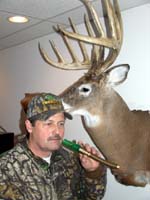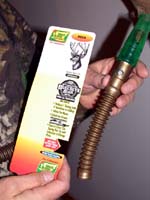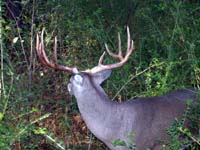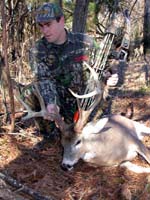
|
Features
|
|
|
|
Books
|
|
|
|
Fun & Games
|
|
|
|
Contact Us
|
|
|
John's Journal... Entry 173, Day 2
SECRETS FOR CALLING BUCKS
Secrets For Calling Bucks
 EDITOR'S
NOTE: Jerry Peterson is the founder and product
designer of Woods Wise Products, the makers of quality game calls in Franklin,
Tennessee.
EDITOR'S
NOTE: Jerry Peterson is the founder and product
designer of Woods Wise Products, the makers of quality game calls in Franklin,
Tennessee.
QUESTION: How do you call bucks during the prerut?
PETERSON: During the prerut, use only social sounds. To remember which
calls to use, think of ABC -- (A) attention grunt, (B) bleat and (C) contact
call. The attention grunt is a simple, short, soft, little grunt. The
bleat is not the long, drawn-out estrous bleat but is short. The contact
call starts low and rises in pitch then falls off. It is a form of a bleat.
 You
can use these calls year-round, and they work effectively on both bucks
and does. You can make prerut calls on a variety of products. I would
use the Bullseye Buck (for all ABC sounds) from our product line. To make
the attention grunt, use the tube at its shortest length. To get the highest-pitch
grunt out of it, don't cover the holes. Again, just blow short and brief.
Make the bleat with a short inhale on the tube. Make the contact call
by starting the plain bleat, inhaling, covering the hole midpoint, and
letting it up. You also can use the Blue Doe to make the bleat and the
contact call using the same hole in the tube feature.
You
can use these calls year-round, and they work effectively on both bucks
and does. You can make prerut calls on a variety of products. I would
use the Bullseye Buck (for all ABC sounds) from our product line. To make
the attention grunt, use the tube at its shortest length. To get the highest-pitch
grunt out of it, don't cover the holes. Again, just blow short and brief.
Make the bleat with a short inhale on the tube. Make the contact call
by starting the plain bleat, inhaling, covering the hole midpoint, and
letting it up. You also can use the Blue Doe to make the bleat and the
contact call using the same hole in the tube feature.
One other favorite call of mine, especially during bow season, is what we call the Bite Me Buck/Doe. It has soft-rubber, removable cartridges so they are very comfortable to use inside your mouth.
QUESTION: When doing a calling sequence with a grunt
call, how many calls do you make, how often do you make them, and what
sequence do you give?
 PETERSON:
That depends on how much the wind is blowing, how open the woods are,
and how well the sound will carry. As a rule, I usually call blindly on
a three-call sequence. The first call is to get their attention and hopefully
to stop the deer. The second call gives the deer the general direction.
Then, I usually wait perhaps 30 seconds to a minute and give the third
call to reinforce the direction to a deer that has heard the first two
calls. In the early season, I make short calls without much volume to
them. I call more often and softly because when you up the volume, you
change its meaning. The louder the call, the more aggressive the call
you're making. In the early season, you want to be as sociable and unaggressive
as you can. And don't underestimate how far a deer can hear.
PETERSON:
That depends on how much the wind is blowing, how open the woods are,
and how well the sound will carry. As a rule, I usually call blindly on
a three-call sequence. The first call is to get their attention and hopefully
to stop the deer. The second call gives the deer the general direction.
Then, I usually wait perhaps 30 seconds to a minute and give the third
call to reinforce the direction to a deer that has heard the first two
calls. In the early season, I make short calls without much volume to
them. I call more often and softly because when you up the volume, you
change its meaning. The louder the call, the more aggressive the call
you're making. In the early season, you want to be as sociable and unaggressive
as you can. And don't underestimate how far a deer can hear.
QUESTION: What about rattling for deer in the early season?
PETERSON: Rattling is probably one of the best-kept secrets of the early
season. Most people wait until the prerut or the rut to begin to rattle.
Around 60 percent to 65 percent of the bucks I rattle up every year are
rattled up while the bucks are still in bachelor groups well ahead of
the season. Bucks spar first. The key to effective sparring sounds is
to keep the activity in short little clinks, stopping and starting. I
once decided to spar until the first buck came in. I sparred for over
an hour before he made a beeline over to the tree. As soon as the bucks
come out of velvet, they start sparring with each other. Sparring as opposed
to all-out fighting is a sport among the bucks that has its social purpose.
Each buck learns a little bit about the other bucks and where they fit
in the pecking order. This behavior is like kids wrestling in a school
yard. Even though they are best friends, after a little sparring match,
they come away with an understanding. John says he can whip Bill, and
Bill secretly hopes he never has to fight John.
 QUESTION:
What about the bleat call (the cow-in-the-can call)?
QUESTION:
What about the bleat call (the cow-in-the-can call)?
PETERSON: You should use bleat calls in the prerut. The can call is more
of a longer bleat and more appropriate to the type of estrus bleating
the does are doing during the rut itself. There is one call, or form of
bleat, which bucks make. It is a bawling sound. It sounds very much like
a calf as opposed to the nasally bleat of a doe. This is great buck-to-buck
communication when the bucks are still in a bachelor group. In fact, I
like to use the bawling sound with my sparring as opposed to the grunting,
because the bawling is a louder call than a grunt. And I know I get a
little more distance with it when I'm using that call. To get the bawl
sound, you have to have a call tuned specifically to make this sound.
It is a grunt, not the rumbling sound you would get when you blow a grunt
call. If you blew a grunt call for a longer amount of time, then you'd
have an aggravated grunt call, which has an entirely different, negative
meaning.
For more information on Woods Wise Products, call 1-800-735-8182, or visit their website at www.woodswise.com.
TOMORROW: PRERUT CALLING
Check back each day this week for more about SECRETS FOR CALLING BUCKS ...
Day 1 - Understanding The
Rut Phases
Day 2 - Secrets For Calling Bucks
Day 3 - Prerut Calling
Day 4 - The Rut and Post-Rut
Day 5 - The Importance Of Calling